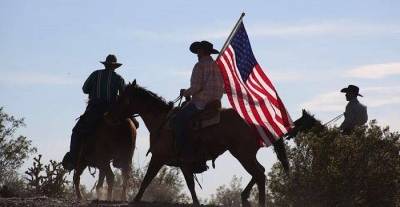| Online: | |
| Visits: | |
| Stories: |

| Story Views | |
| Now: | |
| Last Hour: | |
| Last 24 Hours: | |
| Total: | |
Lessons Learned & Lessons Missed from the Attempted Land Grab

EPA administrator Gina McCarthy stated that the EPA and the USDA are going to regulate 56 farm practices
Dr. Ileana Johnson Paugh / Canada Free Press
The recent standoff at the Bundy ranch in Nevada has taught us many lessons, but the most important one was missed.
We learned that the government will do anything to private citizens in order to grab land and private property either under the guise of protecting an “endangered” desert tortoise that is actually overpopulated, or getting rid of “feral” and destructive “trespassing cattle” grazing the land for generations, cattle that are in the way of developing a $5 billion Chinese solar panel plant (ENN), and the exploitation of rare earth elements in the larger adjacent area.
Mr. Bundy was too stubborn, the last rancher standing in Clarke County, Nevada, clinging to his inconvenient “feral” cattle, his agreement with the State of Nevada, with the Bureau of Land Management, BLM, his “prescriptive rights,” and his ranch. I thought cattle were domesticated, not feral, and were raised for beef consumption.
Mr. Bundy may or may not owe the $1 million in grazing fees. The case is not clear-cut on either side and may go all the way to the Supreme Court. If someone trespasses or uses someone else’s land for at least five years without the owner of the land taking legal action, that person can claim prescriptive rights. In Mr. Bundy’s case, twenty years have lapsed since payment of fees have been in question.
Mark Levin explained in his April 11th broadcast that “Bundy had agreements with the State of Nevada before the BLM claimed jurisdiction.”
The sad lesson was how innocent animals were hurt and no animal protection agency stepped forward to protest their treatment, how people were manhandled, tasered, frightened by fully armed and menacing agents, and how massive, extreme, and expensive was the government’s response to one farmer who allegedly has not paid $1 million in grazing fees. How many people are currently in court that have embezzled other people’s money, or have failed to pay money owed to the federal government, yet have not received the Bundy treatment?
Another lesson missed was that the federal government has huge land holdings, particularly in the southwest. Lord Monckton mentioned in his article that “almost one-third of the entire 2.3 billion acres in the country are owned by the federal government.” He is of the opinion that there should be a statute of limitations on civil debt, including the right of use.
The BLM citing alleged environmental damage by the Bundy Ranch was not credible because ranchers grow up caring for the environment that provides their livelihood. They are not likely to abuse the land or any property that sustains them and their families for generations.
The other important lesson missed was that putting so many ranchers out of business, coupled with other variables, is having a negative impact on the price of beef. U.S. cattle inventory is at a 63-year low for several reasons. William Hahn of USDA explained that “cow numbers were down… and the lower supply meant higher prices.”
The U.S. is the world’s largest beef producer and Texas is the leader. Demand from China and Japan for U.S. beef has increased. Supply is tight, “everything produced is consumed.” Dry seasons, increased cattle feed prices due to grain use for ethanol are some of the variables affecting supply and beef prices. Wrangling Mr. Bundy’s cattle with helicopters and exhausting some to death certainly would not help the price of beef.
continue at CFP:



